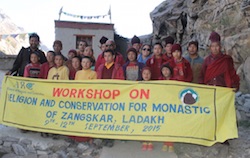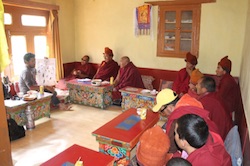|
|
|
|
 |
|
Buddhist projects
 |
 |
 |
The Ladakh and Zanskar Buddhism and snow leopard workshops, 2015 |
ARC is working in India, China, Cambodia, Mongolia, Indonesia and elsewhere, helping local faith communities protect their environment.
Ladakh and Zanskar
After a series of workshops in remote Zanskar, northern India, in summer 2015, supported by ARC and led by the Snow Leopard Conservancy, monks and nuns have committed for the first time to preach the message of snow leopard and other wildlife conservation. Link
here to read more.
Cambodia
 |
 |
 |
Discussing wildlife protection with Buddhist monks in Zanskar, northern India |
ARC helped set up the Association of Buddhists and the Environment (ABE) run by Cambodian monks to protect nature. Their programmes have included protecting forests through working with local communities and ordaining trees, as well as introducing environmental education into rural areas and here to read more.
Asian Buddhist Network
About 550 million Buddhists live in Asia - from Sri Lanka, Cambodia, Laos and Thailand in the south, through Nepal, Bhutan, India and Sikkim to Tibet, China, Japan, Korea, Russia and Mongolia in the north. In the past century many of these countries have experienced political and religious upheaval, war, economic hardship or famine. Others have experienced rapid industrialisation and half a century of peace. Yet in this huge diversity of experiences and cultures there is a great deal that is shared. Link
here to read more about how the Asian Buddhist Network, one of our earliest programmes in the region, began.
Mongolia
Since 1990, Mongolia has seen a massive increase in the number of groups working
in the environmental sector.
However, surprisingly few of them have established direct relationships with one of
the most historical, sizeable, and influential sectors of Mongolian society: the Buddhist
sangha. ARC, in collaboration with Gandan Monastery and the World Bank’s NEMO fund in Mongolia has created a new
handbook in an attempt to address this.
The handbook can be downloaded here, in full, in English
here and here in Mongolian (2MB file). Link
here for more details.
It is the first comprehensive guide to approaching and working with Buddhist
communities in Mongolia, and it explains why this is an area of action and outreach
which could, and should, be explored by environmental groups from both within and
outside Mongolia.
Pages about Mongolian Environmental Wisdom, taken from the Handbook.
 |
 |
 |
Tsagaan Uvgun, the White Old Man of Mongolian mythology. |
The Mongolian Lord of Nature.
Sacred texts, places and ovoos.
Sacred sites
in Mongolia.
Traditional Environmental Law in Mongolia.
The work that the monks, in conjunction with ARC and the World Bank and others, are carrying out to rediscover the sutras about sacred land in Mongolia.
Do you want to support this?
For full contact and address details of Mongolian Buddhist Monasteries, please see page 57 of the
Handbook. And for details of local Development, Environmental and Educational NGOs, please visit pages 58-59 of the
Handbook.
Other links to Mongolian Buddhism and the Environment
Link here to access the news story about the launch of the Mongolian Buddhist Handbook.
Link
here to download the Mongolian Buddhist Handbook in English. (Please note this file is 1.15MB)
Link
here to download the Mongolian version of the Handbook.(A 2MB file.)
Link here to download the guide to the Mongolian Buddhists’ Eight Year Plan (this file is 4.13MB).
Link to Mongolian Case Studies.
And
here on how to make contact with the Sangha.
To download the A3 poster of a thangka about Buddhists protecting Nature, link
here (5.61MB).
Brief History of Mongolian Buddhism.
Buddhism and the Environment.
Women in Buddhism in Mongolia.
Key Figures in Mongolian Buddhism.
Key Meetings in Mongolia.
Mongolian Buddhists and Development.
Mongolian Buddhists and Ecology.
Mongolian Buddhist Hunting Ban.
The Lost Sutras.
|
 |
|
|
|
|
|

